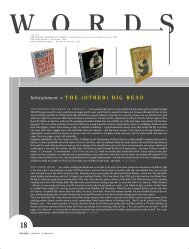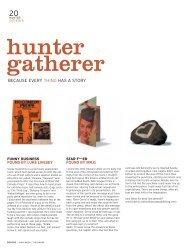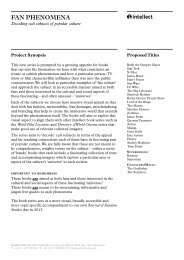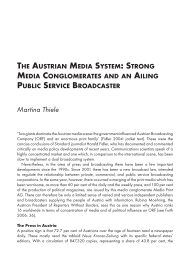Anthem - Intellect
Anthem - Intellect
Anthem - Intellect
You also want an ePaper? Increase the reach of your titles
YUMPU automatically turns print PDFs into web optimized ePapers that Google loves.
Signifying Europe<br />
An anthem as well as a hymn is a song of praise made for communal singing. It<br />
should preferably be reasonably easy to remember and to sing, making it tempting<br />
or even irresistible to join in singing, and this activity of participation is intended to<br />
spill over into some level of identification with what the anthem stands for. In this<br />
way, anthems are constructed to emotionally boost collective identification, through<br />
the medium of voice and sound. Peter J. Martin sees the unprecedented demand of<br />
popular music today in the light of its capacity of forming communities: ‘The closeknit<br />
communities of Romantic mythology have given way to the quest for a sense of<br />
belonging’, where individuals ‘seek to identify themselves with symbolic entities’. Here<br />
‘popular music becomes a useful commodity’, offering ‘a sense of who you are and<br />
where you belong’. 331 Popular songs help construct a wide range of different collective<br />
identifications, while anthems are made for underpinning those that have a more<br />
official character, being supported by formalised institutions, such as nation states.<br />
Malcolm Boyd has analysed a great number of national anthems and divided<br />
them into five main categories, of which the two first are most common: (a) hymns<br />
with a solemn pace and melody (for instance the British ‘God Save the Queen’ or the<br />
European anthem); (b) marches (such as the French ‘La Marseillaise’); (c) operatic tunes<br />
(exemplified by El Salvador and some other Latin American countries); (d) folk tunes<br />
(mainly used in Asia, for instance by Japan and Sri Lanka); and (e) fanfares without<br />
text (found in Kuwait, the United Arab Emirates and other oil states in the Middle<br />
East). 332 Just like the idea of a nation was established in Europe, this is also true for the<br />
sound of national anthems. Except for the few, mainly Asian, examples of folk anthem<br />
category (d) that build upon a Herderian notion of ‘specific musical nationalism’,<br />
expressing a particular ethnicity, Martin Daughtry has argued that most national<br />
anthems tend towards a ‘generic’ musical nationalism, as they by musical means signal<br />
that they are precisely that by adhering to the classical European musical conventions<br />
that have established musical nationalism as a kind of specific supranational genre,<br />
where they are perceived as sounding familiarly ‘anthemic’, rather than specific, to a<br />
particular nation. 333<br />
As a mode of communication, music has several peculiarities advantageous for<br />
communal celebration. 334 First of all, it is based on sounds that involve the ear and<br />
the human voice, but organises these sounds differently than in speech that is based<br />
on a verbal logic of relatively late origins in the history of mankind. What is seen of a<br />
person is primarily the outside surface, while what is heard tends to derive from the<br />
interior of that person’s body, in particular the sonic organs in and around the throat.<br />
The combination of physiological constitution and genetic origin lends to music an<br />
extraordinary emotional reach and subjective involvement that have led many to<br />
understand it as a unique and privileged mode of expression, reaching beyond or<br />
underneath the more conscious modes of visual and verbal communication. Swearing<br />
an oath, proposing to a beloved, crying or laughing—such strong subjective expressions<br />
150












